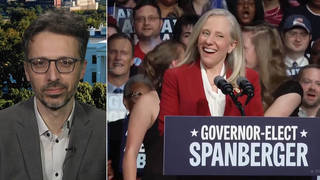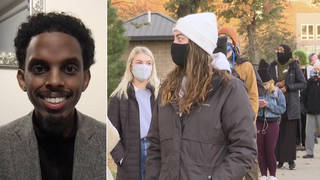
Guests
- Vil Mirzayanovformer Soviet chemical weapons specialist. He believes the gas is a modification of BZ gas, a toxic chemical agent that he worked on. In September 1992, he revealed that the Soviet Union had produced the most lethal binary nerve agent known to mankind. Known as Novichok (the newcomer), it was up to 10 times more powerful than its nearest U.S. equivalent, known as VX. He was jailed twice for whistleblowing.
- Anne NivatMoscow correspondent for the French newspaper Libération. Her book, Chienne de Guerre: A Woman Reporter Behind the Lines of the War in Chechnya (Public Affairs, 2001), tells of how she managed to do what almost no other journalists have done: She covered the war in Chechnya from within Chechnya. Dressed as a Chechen woman, she traveled with civilians, her satellite phone strapped to her belly. She spent the winter of 1999-2000 in Chechnya, surviving the height of the war, and left only when the Russian Federal Security Services detained her. She returned to Chechnya several times and was there in June of this year.
- Mark Wheelissenior lecturer, Department of Microbiology at UC Davis.
Russia is ignoring international requests, including many from the U.S. Embassy in Moscow, to identify the gas which left 117 hostages dead in a Moscow theater raid this weekend. Chechen rebels had held 750 hostages in the theater since last Wednesday. Russian troops pumped the gas into the theater’s ventilation system before raiding the building.
Russian authorities initially claimed the raid was called because rebels had begun executing hostages. But the Moscow Health Community Center reports that only one hostage died of gunshot wounds.
According to The New York Times, U.S. officials say the Russian security police might have used an aerosol version of a powerful, fast-acting opiate called fentanyl. U.S. medical experts say that fentanyl is dangerous to children under 12. Survivors and relatives of victims said that at least 10 of the dead were children.
Meanwhile, U.S. officials say they are confident the Russian authorities did not use an illegal nerve gas in their mission to rescue the 750 hostages from the Moscow theater. Senior U.S. authorities and private experts also say the agent was probably similar to one of an arsenal of nonlethal weapons that the United States is quietly studying for use by soldiers and police officers.
According to The Guardian, respected scientists on both sides of the Atlantic warned yesterday that the U.S. is developing a new generation of weapons that undermine and possibly violate international treaties on biological and chemical warfare.
In Moscow, family members of the victims are angry. Russian authorities have yet to issue definitive lists of victims and survivors or to allow hospital visits even for relatives.
Health officials report they were not notified until a very short time before the raid that they should be prepared to treat patients for overdoses of the gas. Ambulances on the scene were unprepared to treat people. The chief Moscow doctor yesterday said medics are struggling to treat their largely unconscious patients without an effective antidote.
Transcript
AMY GOODMAN: You are listening to Democracy Now! I’m Amy Goodman.
Russia is ignoring international requests, including many from the U.S. Embassy in Moscow, to identify the gas which left 117 hostages dead in a Moscow theater raid this week. Chechen rebels had held 750 hostages in the theater since last Wednesday. Russian troops pumped the gas into the theater’s ventilation system before raiding the building. Russian authorities initially claimed the raid was called because rebels had begun executing hostages, but the Moscow Health Community Center reports only one hostage died of gunshot wounds.
The New York Times is reporting U.S. officials say the Russian security police might have used an aerosol version of a powerful, fast-acting opiate called fentanyl. U.S. medical experts say that fentanyl is dangerous to children under 12. Survivors and relatives of victims said at least 10 of the dead were children. U.S. officials say they’re confident the Russian authorities did not use an illegal nerve gas in their mission to rescue 800 hostages from a Moscow theater. Senior U.S. authorities and private experts also say the agent was probably similar to one of an aerosol of nonlethal weapons that the U.S. is quietly studying for use by soldiers and police officers. According to The Guardian, respected scientists on both sides of the Atlantic warned yesterday that the U.S. is developing a new generation of weapons that undermine and possibly violate international treaties on biological and chemical weapons.
Meanwhile, Moscow family members of the victims are angry. Russian authorities have yet to issue a definitive list of victims and survivors or to allow hospital visits even for relatives. Health officials report they were not notified until a very short time before the raid that they should be prepared to treat patients for overdoses of the gas. Ambulances on the scene were unprepared to treat people. The chief Moscow doctor yesterday said medics are struggling to treat their largely unconscious patients without an effective antidote.
We’re joined right now by Vil Mirzayanov, a former Soviet chemical weapons specialist. He believes the gas is a modification of BZ gas, a toxic chemical agent that he worked on. In September 1992, he revealed that the Soviet Union had produced the most lethal binary nerve agent known to mankind. Known as Novichok, “the newcomer,” it was up to 10 times more powerful than its nearest U.S. equivalent, known as VX. He was jailed twice for whistleblowing. He joins us on the line now from Princeton.
Welcome to Democracy Now! Dr. Mirzayanov.
VIL MIRZAYANOV: Yes. Thank you.
AMY GOODMAN: Can you start off by telling us your reaction to the use of this gas by the Russian special forces?
VIL MIRZAYANOV: Yes. I know about all this history. But I believe that despite these explanations in New York Times today, this fentanyl and the other some kind of drugs were used in this time, it’s tough to buy this information. It’s more probably it’s hint, maybe some kind of prompting to — for Russian government to agree with this fentanyl version. I don’t know what’s the goal of these authors. But as far I know, it’s not so easy to develop, and then [inaudible] develop and then produce such a sophisticated agent. I’ve been participating in this works on development of technology, BZ gas, under the name of Substance 78, in 1980s. During these experiments, during this development of technology, my colleagues discovered that one of versions of this agent, a little bit altered version of this, that is very good and [inaudible] agent, [inaudible] drug. This drug passed all tests, including tests in military hospital, Moscow hospital. But because this drug was still classified and directly connected with prohibited BZ gas, sure, it’s a secret gas still. And secondly, it was the state-issued organic chemistry technology, where I was working 26 years. Last position, my position there was chief technical counterintelligennce department. So, we used this facility to produce this agent. And then, after that, sure, our leadership, the formal leadership, promoted this drug for anti-terroristic — as anti-terrorist weapon. So —
AMY GOODMAN: Were you surprised that the Russian forces used the gas that they did?
VIL MIRZAYANOV: I was not surprised, unfortunately, because Russians, Soviet, they have this government, the same Soviet government. They have the same mentality. When coming some problem, they all the times using more easy, simplified way for resolution this problem. If it’s political — looking for a political solutions, they all the time taking the side of use power, force. For me, it’s not surprising, but shocking, sure. The result is striking, because I’m also guilty. I participated some time in development of this drug.
AMY GOODMAN: We’re going to break for stations to identify themselves. We’re also joined by Anne Nivat, who is Moscow correspondent for the French newspaper Libération, who’s covered the Chechen War from inside Chechnya dressed as a Chechen woman. We’ll also talk to Mark Wheelis, who’s a senior lecturer at the Department of Microbiology at UC Davis, about U.S. biological weapons that are being developed. Stay with us.
[break]
AMY GOODMAN: You’re listening to Democracy Now! I’m Amy Goodman, as we continue to talk about what happened in Russia at the Moscow theater. Chechen rebels laid siege to the theater. But the resultant level of death, more than 117 Russians and others believed dead, a result of the use by Russian special forces of a gas, which they have yet to identify. We’re talking to Dr. Vil Mirzayanov, who is former Soviet chemical weapons specialist, and Nan Nivat — Anne Nivat, who is Moscow correspondent for the French newspaper Libération.
Anne Nivat, we spoke to you when you came to the United States to talk about your coverage of the Chechen War within Chechnya. Can you talk about your response to what’s happened in Moscow?
ANNE NIVAT: Well, in fact, I’m absolutely not surprised at all by what has happened in Moscow, because — and the most important thing I would like to draw your attention to is that the people who took this theater are not Chechen rebels, because one has to draw a difference between the Chechen rebels, the fighters, the ones who are fighting against the Russian troops in Chechnya in order to obtain the independence from Russia, and some other groups such as this one, the commandos, the group of the people who call themselves mujahideen, who came to Moscow in order to die. Don’t forget that that was their first goal. They say they — they expressed the will to die. As soon as they arrived in Moscow, they went — they arrived, they came into Moscow to die first, to die as shaheed, “shaheed” which means because they think that in order to — in fighting against the infidels, they’re going to be welcome in paradise. And that’s exactly what they wanted to accomplish in Moscow. And those people are Wahhabis. And the Wahhabis, this kind of extremist fundamentalist, is not the majority in Chechnya. So, that is very important to underline.
And I think that what happened in Moscow is not surprising because of the refusal of the Kremlin, after three years of the beginning of this conflict, to have any — to start any kind of negotiations with the rebels. And the rebels are led by the president. His name is Aslan Maskhadov. I don’t even remember how many times since the beginning of the conflict, which is October '99, how many times Maskhadov has wanted to start a negotiating process, a peace process. And so far, on the Kremlin side, there is absolutely no chance that this could happen. And I think that not even a second, Mr. Putin, the Russian president, had any intention to start the negotiation process during this hostage taking. It's just the opposite. And the result of what happened is that now it will be even more difficult for the Chechen conflict to be resolved. And that is what makes it even more dangerous, to my point of view, because what happened Wednesday evening can happen again. That is absolutely evident. It can happen again in Russia, because those people who are doing it are not afraid to die, and they are not under anyone’s control.
AMY GOODMAN: What about Putin saying that he would launch preemptive attacks in Chechnya?
ANNE NIVAT: Putin has tried to conduct a so-called anti-terrorist operation in Chechnya, because don’t forget that what’s happening in Chechnya is not even called a war. When I went — I’ve been there covering it. I’ve been living among Chechens. I spent at least seven months in a row under heavy bombing. Believe me, it’s a full-time war, what’s going on down there. Well, yet the Kremlin is calling it an anti-terrorist operation.
So, an anti-terrorist — after three years, I don’t really see any success of this anti-terrorist operation, because, first of all, what happened in Moscow is the vivid proof of the fact that the war is not over, the way the Kremlin is suggesting it is. Second of all, there is absolutely no normalization process going on in the Chechen Republic, as, again, the Kremlin is pretending it is. I was there last time in June for five weeks. And unfortunately, I could only — I can only say that the situation is absolutely not improving. It’s just the opposite. It’s just worsening every day.
There are no infrastructure left. The schools, some of them reopened, but most of them didn’t. There was absolutely no future for anyone in Chechnya, no jobs, nothing, only fighting from — on the Chechen side, it’s guerrilla war. And on the Russian side, you have a bunch, I mean lots, 80,000 troops there, trying to — pretending that they are in control of the republic, whether in fact they’re only controlling a few checkpoints, road checkpoints on main roads of Chechnya, in the streets, and they are not even controlling them, because I’ve been the witness of how often anybody, including Chechen rebels, can go through any kind of checkpoint by bribing, just bribing the soldier who is standing there.
AMY GOODMAN: Anne Nivat is Moscow correspondent for the French newspaper Libération. On the line with us also, scientists Vil Mirzayanov. And also with us is Mark Wheelis, senior lecturer, Department of Microbiology at University of California, Davis. I wanted to switch gears back to the chemical weapons that were used and the fact that respected scientists on both sides of the Atlantic are warning that the United States is developing a new generation of weapons that undermine and possibly violate international treaties on biological and chemical warfare, and tie this in to what was used against the rebels and, in the end, the captive audience inside the church — inside the theater. Mark Wheelis, can you talk about your understanding of what was used, and what the U.S. is developing here?
MARK WHEELIS: Yes. I really don’t know what was used, and I think it’s premature to try to be too definitive about that. The primary speculations have been BZ, a supposedly nonlethal agent that has been in military arsenals for quite some time, and some form of inhalable opiate. But the information that’s available on the internet so far is contradictory and inconclusive, and I don’t think at this time that we can say with any certainty what was used.
What doesn’t surprise me about this is the fact that the Russian special forces troops were equipped with putatively nonlethal chemical agent for use in situations like this. They presumably had trained with it. It was part of their operating procedures. This is — although I had not known that they were doing this before, it certainly doesn’t surprise me, knowing that the United States has been for well over a decade very actively pursuing so-called nonlethal weapons, for exactly this kind of situation.
The use of any chemical weapon, lethal or nonlethal, is prohibited as a method of warfare by the Chemical Weapons Convention. But there is an exemption in the Chemical Weapons Convention that allows chemical agents to be used for law enforcement purposes. This exemption has, I believe, two principal purposes. One is to allow countries to use riot control agents for domestic riot control. And the other is to allow those countries with — that still have capital punishment to use chemical agents for enforcing capital punishment. So that law enforcement exemption was necessary to achieve international agreement on the Chemical Weapons Convention. But it was the very clear intent that no chemical agent, lethal or nonlethal, should be used by militaries as a method of warfare.
Now, the U.S. has interpreted the term “method of warfare” to refer only to international conflict — that is, conflict between nations. And so, their legal experts — the Pentagon’s legal experts assert that the the use of nonlethal agents is legal in what they call military operations other than war, which would include counterterrorism, hostage rescue and the like. This is, in my view, a bit disingenuous. Even if we interpret — even if we accept that very narrow interpretation of the phrase “method of warfare,” which I do not think was intended to be interpreted so narrowly, but even if we — even if we grant the U.S. the right to interpret that phrase so narrowly, it’s still not clear that most military operations other than war would, in fact, be law enforcement actions, which would be also necessary for it to be legal.
In any event, despite the possible illegality of developing nonlethal chemical agents for military use, and developing the military munitions, like mortar shells, to deliver them, the United States has been plunging very actively, full speed ahead, in this area. I think, you know, the lessons of Somalia, Lebanon and the like suggest that, to military tacticians, that we desperately need better ways to handle these very messy modern engagements in which combatants and noncombatants are intermixed. So, the United States has been actively engaged in such a program, developing such weapons, both calmative, to calm people down, and so-called malodorants, which are agents which smell so offensive that the only real option to people exposed is to wretch and run. At least these two kinds of agents are under active development, and munitions to deliver them.
Given that the U.S. is doing that and given that the U.S. activity in this area is pretty well known, it’s no surprise to find that other countries in the world are also moving down this path. I think this is a matter of very great concern. I think that the widespread proliferation of nonlethal chemical — so-called nonlethal chemical weapons — and as an aside, I would say that the substantial mortality in Moscow is a vivid reminder to us that there really is no such thing as a nonlethal weapon. There are simply weapons with somewhat less lethality than others. But the the widespread proliferation of this kind of weapon, I think, would be extremely destabilizing. It would provide a rationale for developing them, the artillery shells, the missile warheads, the mortar shells, etc., to develop chemical agents, which would otherwise be prohibited under the Chemical Weapons Convention.
AMY GOODMAN: Professor Wheelis, the U.S. blocked an attempt to give the convention teeth with inspections so that member countries could check if others were keeping the agreement?
MARK WHEELIS: Well, it was actually a different but closely related treaty. There are two treaties: the Biological Weapons Convention, signed first, in 1972, and the Chemical Weapons Convention, signed later, in 1993. The Chemical Weapons Convention, as it was negotiated, had enforcement provisions in it, that allows for international inspections of — both routine of facilities that possess certain chemical agents, declare certain chemical agents, and of other chemical facilities that perhaps have the potential for producing them, and of suspect sites. There’s no such provision in the Biological Weapons Convention, and the United States was actively engaged in about a 10-year process of trying to negotiate such an additional protocol.
AMY GOODMAN: We only have 10 seconds.
MARK WHEELIS: OK, but we backed out on it last year, probably to conceal — I think, to conceal active, probably defensive research, but research that stepped over the line.
AMY GOODMAN: Like programs to produce dried and weaponized anthrax spores officially for testing U.S. biodefenses?
MARK WHEELIS: Exactly, and other things that were revealed by Times reporters last year.
AMY GOODMAN: Well, I want to thank you for being with us, professor Mark Wheelis of University of California, Davis; Anne Nivat, Moscow correspondent for French newspaper Libération; and Vil Mirzayanov. And that does it for this segment.












Media Options